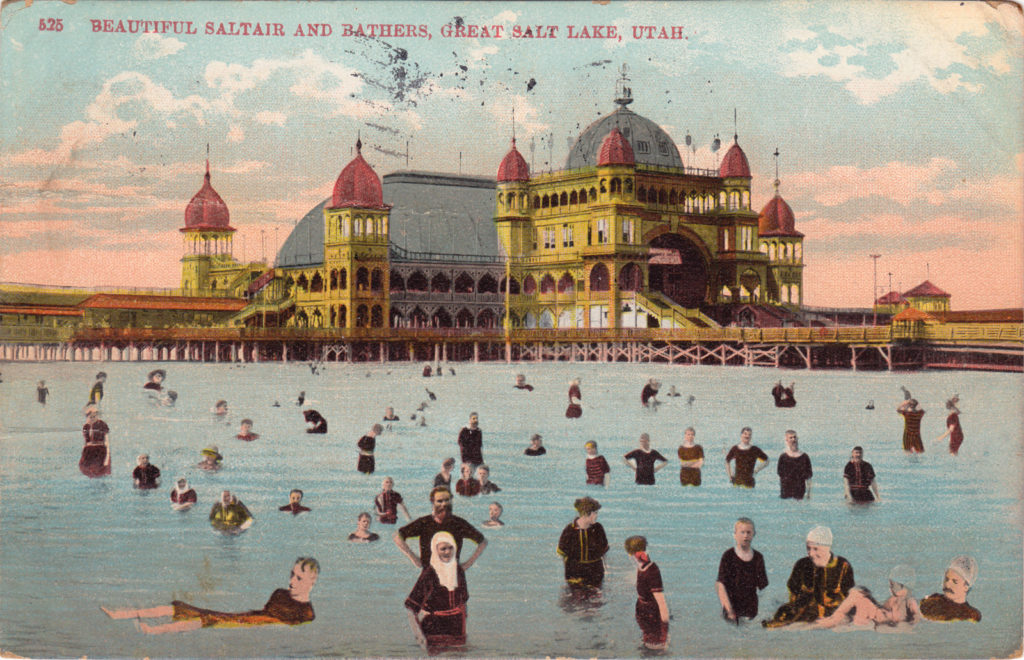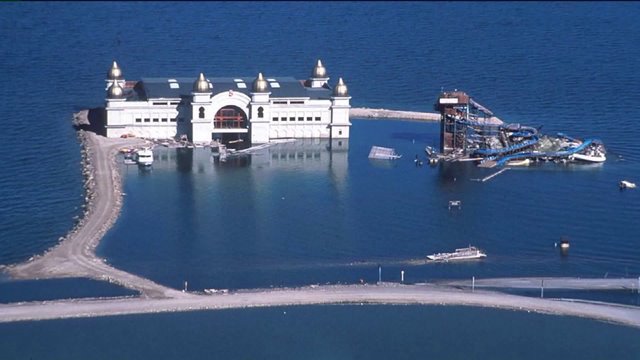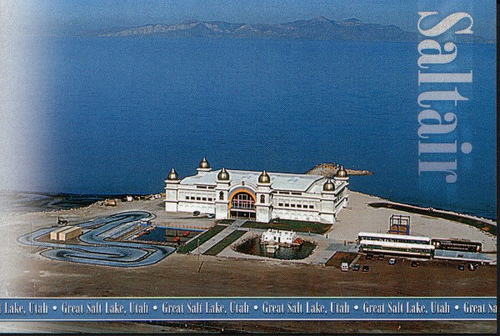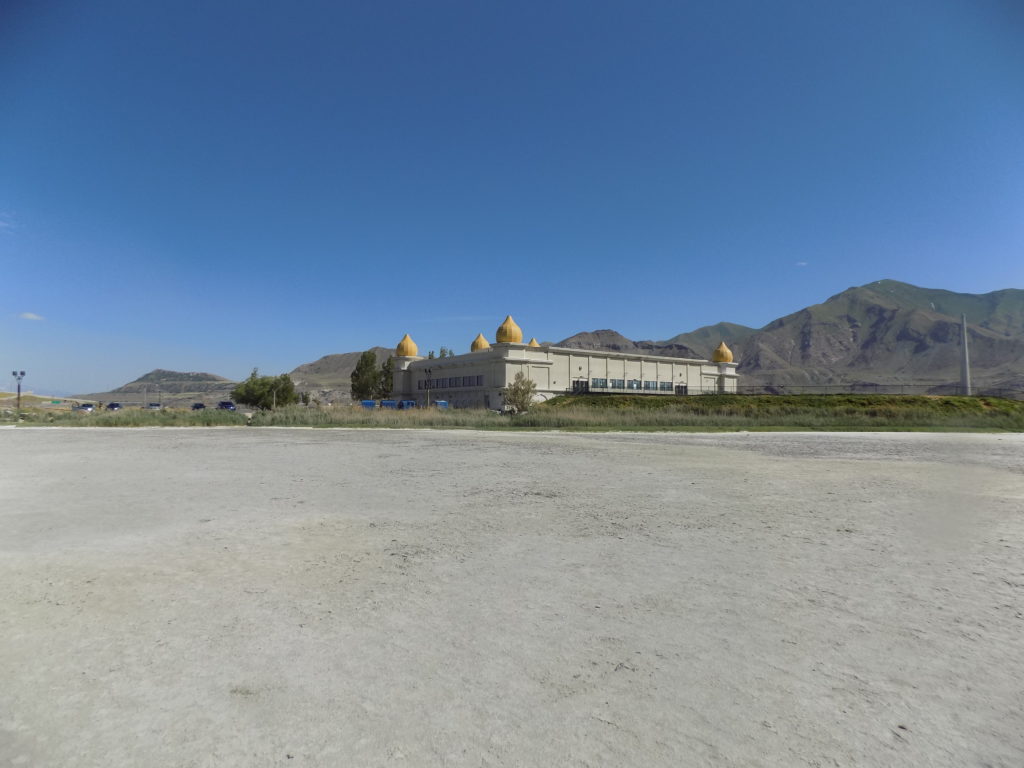As you have likely discerned, Friday was a busy day in and around Salt Lake City and while I may not have a lot left to do, I do have plenty left to write. (Surprise!) Setting out from Ogden, we’re going to head mostly south and a little bit west. For those following along on Google Earth, the next destination is The Great Saltair in Magna, Utah.
I’ve seen fire and I’ve seen rain (and winds and floods).
I’m going to guess that if I were to ask you for the first adjectives that come to mind when you think of the believers who make up the Church of Jesus Christ of the Latter-Day Saints, you wouldn’t shout, “They love to party!” or “They love to dance!” Part of that probably stems from the reputation that Mormons eschew the consumption of alcohol, coffee, and tea.
(Those who think they have a prohibition against caffeine are mistaken. Here’s what the Salt Lake Tribune had to say about that myth:
The LDS Church’s health code, known as the Word of Wisdom, was issued in 1833 by Mormon founder Joseph Smith. It condemns alcohol, tobacco and “hot drinks,” which church leaders have subsequently described only as “coffee and tea.”
They say nothing about reasons for singling out those two drinks. Many members have presumed it’s because they contain caffeine and thus eschewed any beverages — especially soda pops — containing the stimulant.
The LDS Church recently reiterated its longtime position that the only barred drinks were alcohol, coffee and tea. That left church-owned Brigham Young University having to explain why it did not serve or sell caffeinated colas. “There’s no customer demand,” school spokeswoman Carri Jenkins said. BYU students then launched a petition drive to exhibit the demand.
Here’s another myth the paper dispelled in a story from 5 November 2012:
4. Mormons don’t dance
This falls in the “Mormons are like the Amish” misconception. Wrong. Dancing is fine. It’s a long-standing pleasure for the more faithful dating back to Joseph Smith and Brigham Young. BYU dance troupes have won international acclaim.
In fact, historically, Mormons have relished singing and dancing. Many of the accounts I read about their westward migration contained reports of how vigorously the pioneers would sing and dance at the end of a long and strenuous day’s journey.
The earliest pioneers had to adapt to the land as well as adapting the land to their needs so building places for community recreation wouldn’t have great primacy. However, by 1870, the first known resort called Lake Side opened near Kaysville about 20 miles north of Salt Lake City. In the ensuing decades, several more, mostly small resorts, opened (and some closed) along the lake – some of better repute than others.
All of that changed in 1893 with the opening of Saltair near the town of Magna. Conceived as the Western counterpart to Coney Island, Saltair, was jointly owned by a corporation associated with the LDS Church and another private entity – the Salt Lake & Los Angeles Railway – which was created for the express purpose of building a 14-mile rail line from Salt Lake City to serve the resort. A trip cost 50 cents and included admission to Saltair.
Built over the lake itself on more than 2,000 10-inch wooden pilings at a cost of $350,000, Saltair opened on Memorial Day 1893. It originally had 1,000 bathhouses. Because the church held a 50 percent ownership stake, Saltair was viewed as a more wholesome alternative to most of the other lakeside resorts of the time although some viewed it skeptically because it was open on Sunday and because it served coffee, tea, and alcohol.
[Image from postcardroundup.com].
The original Saltair’s reputation grew to the point where it became the most popular family destination west of New York drawing upward of 250,000 visitors annually. But a harbinger of things to come happened in 1910 when a pair of windstorms destroyed 200 bathhouses and other structures. That was only the beginning of nature’s assault on the resort.
On 22 April 1925, a fire destroyed the original Saltair pavilion and a few of the resort’s other buildings. Fortunately, it was the Roaring Twenties. So, funded by new investors – most of whom were prominent Mormons – they not only built a new pavilion at the same location that became known as Saltair II, but they expanded the resort.
The new resort reopened in just two and a half months and featured a roller coaster, a tunnel of love, six bowling alleys, a Ferris wheel, fishpond, fun house, pool halls, penny arcade, photo gallery, shooting gallery, and roller-skating rink. It was also billed as having the world’s largest dance floor, where 5,000 people could fox trot at once in the open-air hall.
Still, its troubles continued. A fire damaged its roller coaster and several other of its rides in 1931. In 1932, a windstorm killed two construction workers. In 1933, the lake’s waters receded so far that it forced the construction of a new miniature railway to carry swimmers between the resort and the water. Fire struck again in 1939, destroying the pier.
The rationing of food and other resources and the reduction in the availability of human capital forced Saltair to close during the Second World War. When it reopened after the war, it faced heightened competition from other, more convenient entertainment choices. The resort’s allure faded and it closed in 1958. Still, more than one attempt was made to revive it over the next decade. They all failed and in 1970 someone deliberately started a fire in the middle of the dance floor destroying the second Saltair pavilion.
But we’re still not done with the history (and disasters) at Saltair. A new group of investors decided to try to revive it again in 1981. They constructed a new pavilion out of a salvaged U S Air Force aircraft hangar approximately a mile west of the original. A few months after the new pavilion opened, it looked like this:
It took a few years but the waters receded and once again new investors restored and repaired the facility. Unfortunately, in what is a natural process for the Great Salt Lake, the waters continued to move away from the site making it of little use as a lakeside resort. What the owners hoped for can be seen in this postcard
but what they had ended up looking more akin to what I saw the day of my visit.
(I took this photo with no zoom standing about halfway between the building and the lake.)
Although it fell into disuse in the late nineties and early 2000’s, in 2005 investors from the music industry pooled together to purchase the building to use as a concert venue. Between 2005 and 2011, the list of performers included George Clinton, Marilyn Manson, Rob Zombie, Ruth Mendoza, Bob Dylan, The Used, Dave Matthews Band, The Black Crowes, Deadmau5, Tiesto, DJ Baby Anne, Evanescence, and Panic! at the Disco. It operates still to this day.
Note: In keeping with my 2022-2023 reformation of the blog into shorter entries, backdated to maintain their sequence, any comments on this post might pertain to its new configuration. See the full explanation in the post Conventions and Conversions.




Todd, what a primo video of the brine flies (and creepy, by the way). My mom’s side of the family had a significant number of Mormons. I grew up with the stories and the mysteries. And remember my Aunts drinking something that was the Mormon equivalent of coffee – without being coffee. Sadly I don’t remember the name.
I recently heard on NPR that Salt Lake City has declared that they will be solely powered by renewable energy by 2032. I don’t know if this figured into the daily news, but it made national news.
They were creepy to walk through, too.